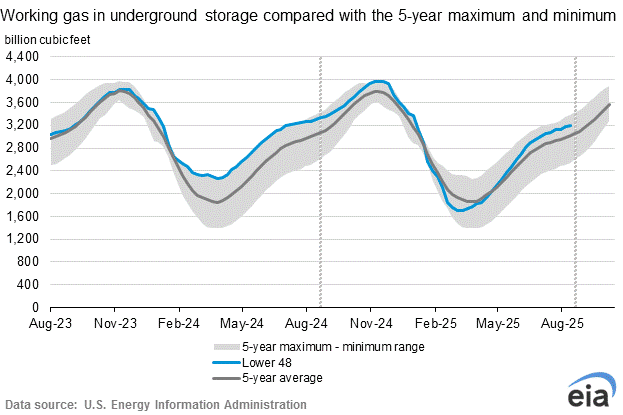Energy Markets Update
Weekly natural gas inventories
The U.S. Energy Information Administration reported last week that natural gas in storage increased by 55 Bcf. There was an injection for the same week last year of 115 Bcf while the five-year average injection is 83 Bcf. Total U.S. natural gas in storage stood at 2,482 Bcf last week, 17.1% less than last year and 5.8% lower than the five-year average for this time of year.
Heat wave applying upward pressure to US natural gas market
Near term NYMEX natural gas futures experienced a second day of volatile trading in a row, as gas traders respond to high temperatures being experienced on both the East and West Coast. With natural gas as the predominant source in the nation’s fuel mix, elevated gas burn is occurring, as grids keep up with the cooling demand induced by the hot weather. With the majority of the summer due to come and above average temperatures projected on both coasts, prices have risen materially in recent weeks, likely in the expectation of continued high gas burn in the country.
In today’s trading, NYMEX forwards for 2021 Q4 reached as high as $3.85, however latter day trading calmed down, with the strip settling around $3.69/Dth, approximately a 6 cent/Dth increase from the previous day. Today’s trading reflects a 10.4% increase from one week ago, and a 19.3% increase from one month ago for the 2021 Q4 strip. Both prompt months and early 2022 futures have experienced similar volatility, however trading has been more stable for forwards starting in mid-2022.
The last month of trading has pushed summer & fall natural gas pricing past points not seen in over 5 years. If the market closed for August through December at this point in time, settled NYMEX prices would be the highest seen since 2014 for those months. Despite the significant market shift we are seeing, long term trading prices indicate that prices past the winter of 20/21 will align closer to historical averages, rather than the ceiling prices we are seeing for the remainder of 2022.
Keen buyers should be on the lookout for market declines coming out of the summer. While far from a guarantee, past trading trends have shown market declines can happen during fall trading periods, as the fear of hot summers ease and winter forecasts crystallize. However, for the immediate future, high NYMEX trading prices are here to stay.

Source: NOAA
Western grid operators continuing to handle June heatwave
While markets respond to the recent heatwaves, regional grid operators must also balance their generation pool and ensure reliability for its customers. After experiencing blackouts in the summer of 2020, California’s grid operator CAISO, has called on energy end-users throughout the state to mitigate their consumption during peak periods to reduce strain on the grid.
The state’s increasing reliance on intermittent energy sources such as wind and solar, in conjunction with approximately hydroelectric resource declines induced by drought, presents reliability concerns and has put upward pressure on energy prices. The state is also a significant energy importer from the surrounding regions, but record heat in the Pacific Northwest dampens their ability to import, as the PNW must serve its own elevated needs.
The current situation CAISO faces is a strong illustrative example of the challenges grids will face in an industry that is evolving significantly and evidently facing climate change. With monumental deployment of renewable resources to meet the aggressive green energy goals of the new federal administration, in addition to state goals, the nation’s grid operators must hurdle significant challenges in order to continue to meet the population’s power needs.
$73B Infrastructure bill approved by the White House
On June 24th, the White House announced their backing of the $1.2 trillion Bipartisan Infrastructure Framework that would deploy $73 billion on power infrastructure spending. The framework represents the largest long-term investment in American infrastructure, and will target the electrification of public buildings and transportation as well as extensive transmission buildout to facilitate the integration of upcoming renewable resources into the grid. Additionally, the bill would create a nation-wide network of electric vehicle chargers with $7.5 billion dedicated to building 500,000 chargers. A report released by the Advanced Energy Economy found that an investment of $600 billion in advanced energy technologies would add $3.5 trillion to the national economy, generate over 28 million new jobs and save consumers over $74 billion annually on energy costs. The Framework is financed through a cross-section of closing the tax gap, redistribution of unspent COVID-19 relief funds and granting states more autonomy over their unused toll credits. As this infrastructure package gets pushed forward, legislators are working on other energy proposals that would target the creation of a nuclear tax credit program and energy efficiency incentives to catalyze growth in the clean energy industry..
Natural Gas Storage Data


Market Data
Use the filters to sort by region
Market data disclaimer: Data provided in the "Market Data" section is for the newsletter recipient only, and should not be shared with outside parties.



